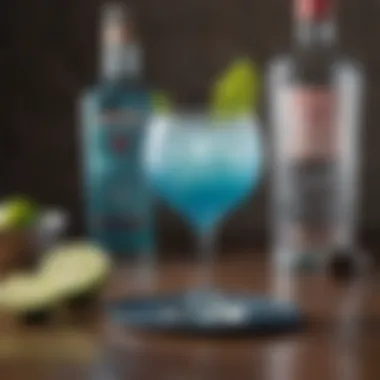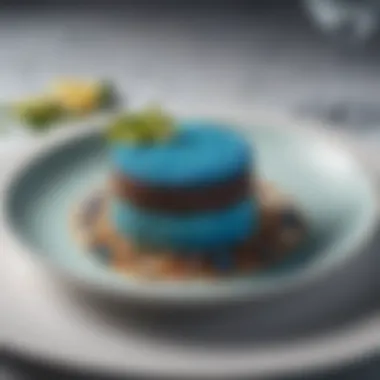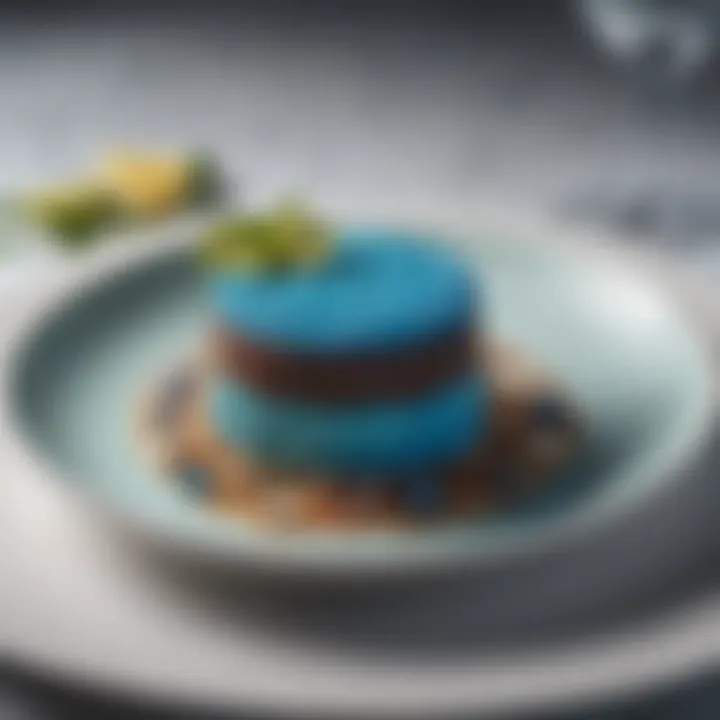Gin and Blue Curacao: A Culinary Exploration


Intro
In the world of mixology and culinary innovation, the interplay between flavors creates experiences that can excite the palate and elevate dining occasions. Two standout ingredients in this realm are gin and blue curacao. Individually, they bring rich histories and distinctive characteristics to the table, but when combined, they create a vibrant fusion that captivates the senses. This exploration will guide food enthusiasts through understanding the nuances of gin, the appeal of blue curacao, and the magic that happens when these two come together.
Gin, known for its botanical complexity, offers a base that reflects the essence of the regions where it is produced. It carries notes from juniper berries, spices, and often citrus, lending a refreshing quality to cocktails. On the other hand, blue curacao, with its striking hue and sweet, citrusy flavor, adds a playful twist to drinks and dishes alike. Its origins trace back to the Caribbean, where the laraha orange thrives, and this provides a delightful counterpoint to the more herbal notes of gin.
This article doesn't just skim the surface. We'll dive deeply into the culinary aspects of integrating these two ingredients, shining a light on recipes, cocktails, and even food pairings that highlight their synergy. The cultural significance behind both gin and blue curacao will also be woven into the narrative, enhancing appreciation for their role in global gastronomy.
So whether you’re a seasoned cook or just starting your culinary journey, the fusion of gin and blue curacao promises to unlock a world of flavors, all while appealing to your sense of adventure in the kitchen.
Prologue to Gin and Blue Curacao
The blend of gin and blue curacao is more than just a colorful drink. It’s a canvas of flavors and a celebration of culinary creativity. In this article, we dive into what makes this combination worth exploring, particularly for those with a passion for gastronomy. Understanding the roots and characteristics of both gin and blue curacao not only enriches your palate but also enhances your cooking and cocktail-making skills.
When you think about modern mixology, gin has become a staple. It’s the spirit that has made a remarkable comeback, morphing from the quaint tipple of yesteryears to a key player in trendy bars. Meanwhile, blue curacao, with its vibrant color and citrus notes, adds a lively twist to any drink or dish. Together, they open doors to innovative recipes and experiences.
As we set the stage for this exploration, one should appreciate the versatility that each ingredient brings. Gin, with its botanical infusion, and blue curacao, known for its sweet orange taste, can enhance dishes beyond just beverages. The culinary applications of these ingredients are boundless, from infused sauces to pairing with seafood that sings. In understanding their nuances, cooks and drink enthusiasts alike can create much more than a cocktail or a meal – they can craft a memorable experience.
The Rise of Gin in Modern Mixology
In recent years, gin has not only resurfaced but has also stamped its authority in the cocktail kingdom. The resurgence can be traced back to the innovative farmers and distillers experimenting with botanicals. Some say it’s like an artist picking up a paintbrush again, ready to recreate their masterpiece.
Key factors in this gin renaissance include:
- Diversity: From London Dry to New Western gins, the array of choices allows bartenders to express their creativity.
- Craftsmanship: Small, local distilleries are leaning on traditional methods while embracing modern techniques, producing unique flavors.
- Cultural Shift: The rise of craft cocktails has shifted consumer interest, with gin fitting perfectly into this narrative as a dynamic spirit.
This engaging popularity also means that more individuals are keen to experiment with gin at home, becoming their own mixologists. The contemporary drinker no longer simply orders a gin and tonic but seeks a complex gin cocktail that tells a story.
Understanding Blue Curacao
Blue curacao is a liqueur that isn’t just about its eye-catching hue; it carries a story that spans tropical islands and citrus orchards. Its vibrant blue color makes an immediate impact, drawing one’s attention right off the bat. But how did it rise to fame?
Let’s break down some key points:
- Origin: Made from the dried peels of the laraha orange, which is native to the island of Curacao, it boasts a uniquely rich flavor profile.
- Taste Notes: While it presents a sweetness, the citrus undertones provide a refreshing zing that harmonizes beautifully with various spirits, especially gin.
- Crafted Uses: Apart from its presence in cocktails, blue curacao can elevate desserts or sauces, offering both color and flavor.
As we proceed, let’s explore the distinctive characteristics and how gin and blue curacao come together to elevate your culinary repertoire.
Historical Context
The historical background of gin and blue curacao is pivotal when exploring their culinary fusion. Understanding the roots and evolutions of these two distinct beverages enriches our appreciation of their intricacies and their roles in today's mixology landscape. The tale of both drinks is not just about taste; it encompasses exploration, trade, and cultural exchange across centuries, highlighting how they became vital ingredients in cocktails and culinary innovations.
The Origins of Gin
Gin's roots can be traced back to the Middle Ages in Europe, particularly within the Dutch distillation practices. It was originally a medicinal tonic, with its most famous early form, genever, being distilled from malted grains. Its popularity increased in the 17th century after its introduction to England, where it evolved significantly.
During this period, gin was seen as a cheap way to sidestep the harsh taxes on beer, leading to widespread consumption. The infamous Gin Craze of the 18th century underscored the drink’s social implications, as it became both a source of joy and a cause for concern among the populace. Despite its tumultuous past, gin has undergone a renaissance, emerging as a beloved spirit that celebrates botanicals, making each gin brand a unique expression of flavor.


Key aspects of gin’s origins include:
- Medicinal Roots: Originally distilled for health reasons, showcasing the shift from medicine to enjoyment.
- Cultural Evolution: Gin mirrors societal changes, from a street drink in London to a fashionable cocktail ingredient in the modern era.
- Variety of Styles: Different styles like Old Tom, Plymouth, and London Dry offer a tapestry of flavors that enhance its appeal.
The Story of Blue Curacao
Blue Curacao has a more niche story, rooted in the Caribbean. Its inception dates back to the island of Curacao, where local oranges, known as Laraha, were used to craft a liqueur with a bright azure hue. The fruit was derived from seeds brought by Spanish explorers who sought to cultivate sweet oranges in the tropics, but the result was a bitter orange that local distillers ingeniously transformed into a versatile liqueur.
The signature blue color of the liqueur soon became its hallmark, often associated with tropical imagery and beachside escapades.
Considerations for the abundance of Blue Curacao's character include:
- Production Tradition: The artisanal process of distilling the zest and peels of Laraha oranges reveals the true craftsmanship behind quality curacao.
- Cultural Symbolism: Its charming color and refreshing flavor capture the essence of Caribbean culture and hospitality.
- Symbol of Celebration: Frequently found in festive cocktails, its usage exemplifies joyous occasions across various cultures.
The fascinating journeys of gin and blue curacao from humble origins to contemporary refinement provide rich context for their culinary interplay, prompting chefs and mixologists to explore their combinations.
Flavor Profiles
Flavor profiles hold immense significance in this exploration of gin and blue curacao. The success of any culinary endeavor relies heavily on understanding how distinct flavors interact. By delving into the unique characteristics of gin and blue curacao, we can appreciate their complementary nature. Knowledge of flavor profiles not only enhances cocktail crafting but also expands the possibilities for innovative culinary applications.
The Botanical Nature of Gin
Key Botanicals Used
Gin is renowned for its botanical composition, which can vary widely among producers. The juniper berry often steals the spotlight, bringing a piney aroma that’s vibrant and refreshing. Other botanicals, like coriander, angelica root, and citrus peels, play crucial supporting roles, each imparting its distinct essence.
This variety allows the creator's fingerprint to shine through, making gin a particularly attractive choice for this discussion. For instance, the use of fresh herbs such as basil or rosemary can lead to unexpected twists in traditional recipes. However, the challenge lies in the balance—too many dominant flavors can overpower and muddle the drink's identity, resulting in confusion rather than harmony.
Impact on Flavor
The impact of these botanicals on the overall flavor profile of gin cannot be overstated. Each botanical contributes a different note, creating a complex bouquet that enchants the palate. The freshness from citrus peels can brighten up a cocktail, while earthy elements like angelica can lend a grounding quality.
The key characteristic here is versatility. This dynamic range in flavor allows gin to adapt to various mixers, particularly blue curacao, which contrasts brilliantly with gin’s complexity. The interplay of these flavors opens doors for genuinely unique cocktails, although one must be cautious not to drown out the innate qualities of either ingredient.
Citrusy Characteristics of Blue Curacao
Production Process
The production process of blue curacao starts with the dried peels of the Laraha orange, native to the island of Curacao. This step is crucial—it captures the unique essence of the fruit, which is known for its bitterness and lack of juice. This process transforms the peels into a vibrant, sweet liqueur that sports a striking blue color, rapidly becoming a staple in various cocktails.
Understanding this production method is key to appreciating the depth of flavor blue curacao can bring. Its sweetness could feel syrupy if overused in a concoction, hence knowing the proper applications is beneficial for achieving balance in each drink.
Taste Notes
The taste notes of blue curacao are characteristically sweet with a hint of citrus. The first sip often introduces bright, zesty flavors that swiftly pivot to a subtle sweetness, leaving a lingering orange flavor on the palate. This sweet-citrus profile is not only appealing but also enhances the overall drinking experience.
One of the unique attributes of blue curacao is its visual allure. The vibrant hue not only captivates but can also influence the perception of flavor, often leading drinkers to perceive it as fresher than it might actually be. While the sweet notes can be a treat, it's essential to balance them carefully with the botanicals in gin to avoid an overly saccharine end product.
In mixing, the key is achieving that sweet spot where flavors mingle without overshadowing each other, allowing the drinker to appreciate the nuanced layers of each ingredient.


By thoroughly understanding these flavor profiles, we emphasize how gin and blue curacao can interact dynamically within cocktails and culinary creations alike.
Mixology Techniques
In the realm of mixology, understanding how to blend flavors and ingredients is crucial, particularly when it comes to distinct spirits like gin and blue curacao. This section digs into the nitty-gritty of mixology techniques that make or break a cocktail. The pairing of gin and blue curacao offers a vibrant visual and a refreshing taste, but it requires finesse to achieve that perfect balance. Having a solid grasp of the ingredients and how they interact not only elevates a cocktail but also enhances the overall dining experience.
Understanding the Balance of Ingredients
Proportions
Proportions in mixology matter a great deal. Think of it as a musical composition – each ingredient plays its part. When using gin and blue curacao, getting the mix just right can create a harmonious blend that sings on the palate. A classic rule is the 2:1 ratio, where two parts gin meet one part blue curacao. This ratio is popular because it allows the robust botanicals of gin to shine without being overwhelmed by the sweetness of blue curacao.
One unique feature of these proportions is how they can be adjusted based on personal taste preferences or the intended audience. For instance, someone who enjoys a more potent flavor can lean towards a higher gin ratio. Meanwhile, those craving a sweeter sip can play with the amounts to find their sweet spot. However, straying too far from these traditional guides can introduce an imbalance that spoils the overall flavor.
Techniques for Mixing
When it comes to techniques for mixing, the approach can really shape the final product. Shaking, for example, adds air and helps to chill the drink, giving it that frothy top that’s often sought after, especially in offerings like the Blue Gin Fizz. On the other hand, stirring is gentle and allows for a more measured melding of flavors, which can be beneficial when working with high-quality gin that deserves to be savored.
One key characteristic of these techniques lies in their ability to influence the texture and temperature of the cocktail. Shaking tends to aerate the mixture, lending a lightness, while stirring retains a more silky mouthfeel. Mixing techniques can also impact dilution, making it an essential factor to consider. Each approach has its merits, and understanding when to utilize each can amplify the drink’s overall impact.
Classic Cocktails Featuring Gin and Blue Curacao
Recipe for a Blue Gin Fizz
The Blue Gin Fizz showcases how well gin and blue curacao can work together. This cocktail has become a staple among mixologists because of its eye-catching color and refreshing flavor. The combination of gin, blue curacao, lemon juice, and club soda invigorates the senses. The effervescence from the soda elevates the drink, making it a crowd-pleaser during social gatherings.
Its unique feature lies in the ease of preparation, which is beneficial for both seasoned bartenders and those just dipping their toes into mixology. To make it, simply shake gin, blue curacao, and lemon juice with ice, strain it into a glass, and top it up with club soda for that sparkling finish. However, over-shaking can lead to a diluted flavor, so striking that right balance is paramount.
Inventive Variations
When it comes to inventive variations, the possibilities are nearly endless, making them a thrilling aspect of cocktail culture. Bartenders around the world experiment with different ingredients and methods to create unique takes on the classic mix. For instance, a Spicy Blue Gin Fizz introduces jalapeño-infused gin, which complements the sweetness of blue curacao beautifully.
One significant aspect that makes these variations attractive is their adaptability. These cocktails can be tailored to seasonal ingredients or personal preferences, which connects the drinker to their surroundings and palate. However, one must be careful not to stray too far from the spirit of the original mix, as that could lead to an unrecognizable final product that loses the essence of its foundation.
"The fusion of gin and blue curacao isn't just about taste; it’s a canvas for creativity in the world of mixology."
By understanding these mixology techniques, enthusiasts can explore the vibrant universe of gin and blue curacao. Whether sticking to the classics or venturing into innovative variants, the right balance can elevate a simple drink into an extraordinary experience.
Culinary Applications
The fusion of gin and blue curacao extends far beyond cocktails; it can elevate the culinary landscape in remarkable ways. By exploring how to implement these two distinct flavors into various dishes, we unlock a whole new world of taste experiences. Whether it’s enhancing sauces, creating marinades, or determining the best food pairings, culinary applications play a crucial role in bridging the gap between mixology and cooking. They allow for a delightful interaction between flavors that can tantalize the palate and surprise the senses. Understanding these applications not only enriches recipes but also encourages creativity in the kitchen, ultimately highlighting the versatility of both gin and blue curacao.
Creating Inspiring Dishes Using Gin and Blue Curacao
Infused Sauces
Infused sauces created with gin and blue curacao can provide a unique twist to a variety of dishes. Gin, with its herbal notes, pairs extremely well with citrus-driven blue curacao, creating a sauce that’s both refreshing and complex. One can incorporate these into reductions by simmering them down with fresh herbs and aromatics, allowing the flavors to meld. This distinct combination makes for a sauce that can complement grilled meats or fish, adding a sophisticated flair to the plate.


The main characteristic of these sauces is their ability to enhance rather than overpower. They offer a beautiful balance, allowing the base ingredients of the dish to still shine through. The infusion process can also lead to a delightful contrast of color due to the vibrant blue hue of curacao, making it not just tasty but visually appealing. A potential downside, however, is that it’s essential to strike the right balance; too much curacao can overpower the flavor, leading to an overly sweet outcome that doesn't fulfill the intended purpose.
Marinades and Glazes
Marinades and glazes using gin and blue curacao are handy tools in culinary exploration. Utilizing gin in a marinade provides a depth of flavor that is both aromatic and refreshing. When combined with the sweetness of blue curacao, it can create a dynamic that’s particularly effective for poultry and pork. Meats marinated in this blend can take on a lovely layer of complexity, while the sugars from the curacao help in caramelizing on the grill, resulting in an appealing char.
What makes marinades appealing is their ability to penetrate the ingredients deeply, infusing them with flavor. This unique feature is essential in achieving a well-rounded taste. However, one must be cautious about the marinating time, as excessive exposure to acid can lead to a mushy texture, negating the desired result. Nonetheless, when done right, these marinades can enhance the taste of dishes, making them memorable and delightful.
Pairing with Food
Complementary Ingredients
Pairing gin and blue curacao with the right ingredients is critical to achieving a well-balanced dish. Ingredients such as fresh herbs, citrus fruits, and even spices can amplify the distinctive notes of both components. For instance, dishes that feature fresh lobster or crab can especially benefit from a drizzle of a gin and blue curacao sauce, as they create a harmonious balance with the sweetness of the seafood. The combination enhances flavors, bringing an intermingled freshness that invigorates the palate.
The distinctive characteristic of finding complementary ingredients lies in their ability to elevate the entire dining experience. Instead of clashing, these ingredients work together to create a symphony of taste. Yet, it's important to experiment; not every flavor will gel well, and knowing when to hold back on certain strong flavors is part of the culinary journey.
Serving Suggestions
How one chooses to present dishes featuring gin and blue curacao can have a substantial impact on the overall dining experience. For example, serving a colorful blue curacao-infused dessert alongside a gin-based cocktail can make for a visually striking table setting. Utilizing elegant glassware or incorporating edible flowers as garnishes can entice and excite diners even before they take their first bite.
The key characteristic in serving suggestions is presentation. An inviting presentation sets the stage for the meal, enticing guests to indulge. However, care must also be taken to ensure that the format is practical and fits the overall theme of the meal. A cluttered appearance can take away from the experience; thus, smart placement and plating of dishes are paramount. It is here that the creativity of the cook truly shines.
Cultural Significance
Examining the cultural significance of gin and blue curacao unveils a rich tapestry of tradition, celebration, and innovation. These two ingredients, while distinct in their own right, come together to tell stories that resonate across various global cultures. Their incorporation into culinary practices reveals not only individual preferences but also societal trends and collective experiences.
Gin in Global Cultures
Gin, with its botanical infusion and varied profiles, has found its niche in many cultures worldwide. From the jazzy bars of New Orleans to the sleek cocktail lounges of London, it has become a symbol of modern mixology. The rise of gin in recent times has also seen it being celebrated in different cultural narratives, marked by local variations and adaptations. Here are a few highlights:
- British Tradition: In the UK, gin has a deep-rooted tradition, often celebrated through gin festivals and classic serves such as the gin and tonic. Its cultural representation combines both historical and contemporary elements.
- Southeast Asia's Twist: In countries like Singapore, the craft cocktail scene has taken hold, giving rise to innovative gin-based cocktails infused with local flavors, such as lemongrass or chili.
- United States Revival: The craft cocktail movement in the United States has reinstated gin’s allure, with bartenders exploring old recipes and creating new classics, often using local ingredients to tell a regional story.
This diversity in how gin is enjoyed around the world is not just about taste; it’s a reflection of social customs, changes in attitudes toward alcohol, and a quest for authenticity in flavors.
The Role of Blue Curacao in Festive Occasions
Blue curacao, with its vibrant color and sweet citrus profile, brings a splash of festivity wherever it's used. It is often more than just an ingredient; it's a visual and flavorful emblem of celebration. Special occasions like birthdays, summer parties, and holiday gatherings often feature this liqueur, not just for its taste but for the ambiance it creates. Consider these aspects:
- Festive Cocktails: Drinks like the Blue Lagoon or Blue Hawaiian showcase blue curacao’s ability to transform a simple gathering into a memorable event. Its striking color serves as a conversation starter.
- Cultural Festivals: In places like the Caribbean, blue curacao is often part of local celebrations, symbolizing the spirit of sunshine and sea. Drinks made with it echo the vibrant lifestyle of these regions.
- Visual Appeal: Beyond taste, blue curacao's bright hue intrigues the eyes. This brings an element of artistry to mixology, making it a favorite for cocktail enthusiasts who revel in presenting visually compelling drinks.
In essence, the cultural significance of gin and blue curacao cannot be overstated. Together, they not only enhance culinary experiences but also serve as conduits of communal joy, tradition, and creativity underlying diverse rituals around the world.
Finale
As we wrap up our exploration of gin and blue curacao, it's clear that their fusion offers more than just a tantalizing mix for cocktails. The significance of these two ingredients extends into cultural realms, history, flavor profiles, and culinary creativity. Diving into their unique characteristics reveals not just how they can complement each other but also how they can elevate an entire dining experience.
When considering the preparation of dishes or cocktails, the balance of flavors becomes paramount. Gin brings forth a complex array of botanical notes, while blue curacao adds a refreshing, citrusy brightness along with its stunning hue. This interplay can enhance not just drinks, but also dressings, marinades, and desserts. Food lovers are invited to think outside the box, exploring potential pairings that might initially seem unlikely but yield delicious results.
One should also reflect on the social and cultural tapestry in which these ingredients are woven. Gin has long been a favored spirit in various cultures, and blue curacao often shines during festive occasions. Their combined presence serves as a conversation starter, a means to create memorable gatherings, and an invitation for adventurous palates.
In summary, the fusion of gin and blue curacao stands testament to the culinary innovation we can achieve through thoughtful pairing. Whether you're a seasoned chef or a casual cook, embracing this unique blend can yield delightful recipes and cherished memories. As our culinary landscapes continue to evolve, the possibilities for integrating such flavors into our daily lives remain boundless, inviting us to experiment with exciting combinations and share those experiences with others.
"Cooking is like love, it should be entered into with abandon or not at all."
So as you continue your culinary journey, keep gin and blue curacao in mind – they just might inspire your next dish or drink!







